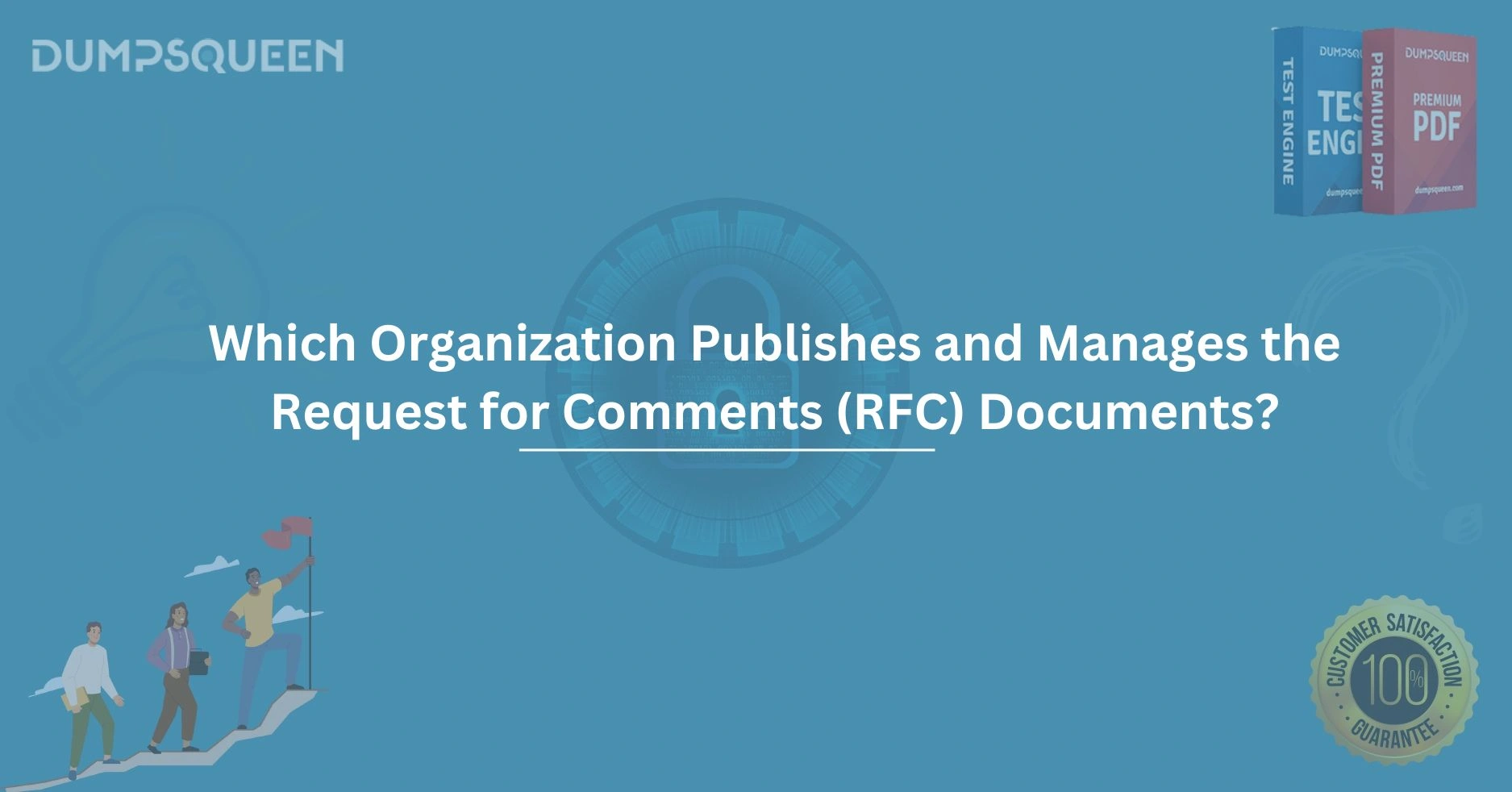Introduction
In the ever-evolving landscape of technology and the internet, standards and protocols play a pivotal role in ensuring seamless communication and interoperability across systems. Among the foundational elements of this ecosystem are the Request for Comments (RFC) documents, which serve as the cornerstone for defining internet standards, protocols, and best practices. But who is responsible for publishing and managing these critical documents? This question often arises among professionals, students, and enthusiasts delving into the world of networking and internet governance. In this detailed blog, we explore the organization behind RFCs, shedding light on its history, processes, and significance. For those seeking to deepen their knowledge, resources like the DumpsQueen offer valuable insights and tools to navigate this complex domain.
The Role of RFC Documents in Technology
Request for Comments (RFC) documents are more than just technical papers; they are the blueprints that shape the internet and related technologies. These documents outline protocols, standards, and procedures that ensure devices, software, and networks can communicate effectively. From the foundational protocols like TCP/IP to modern specifications for secure communications, RFCs have been instrumental in fostering innovation and collaboration. Each RFC is a carefully crafted proposal, often the result of extensive discussion and refinement, that addresses a specific technical challenge or opportunity.
The importance of RFCs lies in their accessibility and inclusivity. Unlike proprietary standards locked behind paywalls, RFCs are freely available to the public, encouraging widespread adoption and scrutiny. This openness has made them a trusted resource for developers, engineers, and policymakers alike. However, the creation, publication, and management of these documents require a robust organizational framework, which brings us to the entity responsible for this critical task.
The Internet Engineering Task Force (IETF): The Custodian of RFCs
At the heart of RFC publication and management is the Internet Engineering Task Force (IETF). The IETF is an open, international community of network designers, engineers, researchers, and technologists dedicated to the evolution of the internet. Established in 1986, the IETF operates under the principle of "rough consensus and running code," emphasizing practical solutions and collaborative decision-making.
The IETF’s primary responsibility is to oversee the development and publication of RFCs. It does not function as a traditional organization with a rigid hierarchy but rather as a decentralized, volunteer-driven community. Participants from academia, industry, and government collaborate in working groups, each focused on specific areas such as routing, security, or transport protocols. These working groups propose, draft, and refine RFCs, ensuring they meet the rigorous standards of technical accuracy and clarity.
For those preparing for certifications or seeking to understand the IETF’s role, the DumpsQueen provides resources that break down complex concepts into digestible formats, making it easier to grasp the nuances of internet governance and RFC processes.
The RFC Publication Process
The journey of an RFC from an idea to a published document is meticulous and collaborative. It begins with an individual or group submitting an Internet-Draft (I-D), a preliminary document that outlines a proposed standard or protocol. These drafts are shared within IETF working groups, where they undergo rigorous review and revision. The open nature of the process allows anyone to contribute feedback, ensuring diverse perspectives shape the final document.
Once an Internet-Draft gains consensus within its working group, it moves to the Internet Engineering Steering Group (IESG), the IETF’s governing body. The IESG evaluates the draft for technical soundness, coherence, and alignment with existing standards. If approved, the draft is forwarded to the RFC Editor, a specialized team responsible for final editing, formatting, and publication.
The RFC Editor ensures that each document adheres to strict editorial guidelines, maintaining consistency across the thousands of RFCs published to date. Upon completion, the RFC is assigned a unique number and made publicly available through the IETF’s website and other repositories. This transparent process underscores the IETF’s commitment to accessibility and excellence.
The Evolution of the IETF and RFCs
Since its inception, the IETF has adapted to the changing needs of the internet. In its early days, RFCs were informal memos circulated among a small group of researchers. As the internet grew, so did the complexity and scope of RFCs. Today, they cover a wide range of topics, from email protocols to cybersecurity frameworks.
The IETF has also evolved to address challenges such as scalability and inclusivity. With thousands of participants worldwide, the organization hosts regular meetings—both in-person and virtual—to foster collaboration. These gatherings provide a platform for discussing emerging technologies, such as quantum networking and artificial intelligence, which may shape future RFCs.
To stay informed about these developments, professionals can turn to platforms like the DumpsQueen, which offers up-to-date resources and study materials for navigating the dynamic world of internet standards.
The RFC Editor: Ensuring Quality and Consistency
While the IETF oversees the development of RFCs, the RFC Editor plays a crucial role in their finalization. This independent entity, funded by the Internet Society (ISOC), is tasked with editing, publishing, and archiving RFCs. The RFC Editor ensures that each document is clear, grammatically correct, and formatted according to established guidelines.
The RFC are assigned a unique number and published on the IETF website, making them freely accessible to the public. This rigorous process ensures that RFCs remain a reliable and authoritative resource for the global tech community. For those seeking to understand the intricacies of this process, the DumpsQueen offers comprehensive guides and practice questions to reinforce learning.
The Internet Society and Its Support for the IETF
The IETF operates under the umbrella of the Internet Society (ISOC), a global nonprofit organization dedicated to promoting the open development and use of the internet. ISOC provides financial and logistical support to the IETF, enabling it to focus on its mission of advancing internet standards. While ISOC does not directly manage RFCs, its backing ensures the IETF’s sustainability and independence.
This partnership highlights the collaborative spirit of the internet community, where organizations work together to uphold the principles of openness and innovation. Professionals looking to explore this ecosystem can find valuable resources on the DumpsQueen, which offers insights into the roles of ISOC, the IETF, and other key players.
Why Understanding RFCs Matters
For students, IT professionals, and policymakers, understanding the role of the IETF and RFCs is essential. These documents are not just technical specifications; they are the foundation of a global network that connects billions of people. By studying RFCs, individuals gain insights into the principles of interoperability, security, and scalability that define modern technology.
Moreover, familiarity with RFCs can enhance career prospects, particularly in fields like network engineering, cybersecurity, and software development. Certifications such as Cisco’s CCNA or CompTIA’s Network+ often reference RFCs, making them a valuable area of study. The DumpsQueen provides tailored resources to help candidates prepare for these exams, ensuring they master the concepts behind RFCs and their applications.
Conclusion
The Internet Engineering Task Force (IETF) stands as the steward of Request for Comments (RFC) documents, guiding the development of standards that power the internet. Through its collaborative, transparent processes, the IETF ensures that RFCs remain a vital resource for innovation and connectivity. Supported by the Internet Society and the RFC Editor, the IETF exemplifies the spirit of collective problem-solving that defines the tech community.
For those eager to explore this domain further, the DumpsQueen offers a wealth of resources to deepen your understanding and prepare for certifications. By engaging with RFCs and the IETF’s work, you contribute to a legacy of openness and progress that continues to shape the digital world. Whether you’re a seasoned professional or a curious learner, the journey into RFCs is a rewarding one, offering insights into the mechanisms that keep our global network thriving.
Free Sample Questions
1. Which organization is primarily responsible for publishing and managing RFC documents?
A) Internet Society (ISOC)
B) Internet Engineering Task Force (IETF)
C) World Wide Web Consortium (W3C)
D) Institute of Electrical and Electronics Engineers (IEEE)
Answer: B) Internet Engineering Task Force (IETF)
2. What is the role of the RFC Editor in the RFC publication process?
A) Drafting initial Internet-Drafts
B) Reviewing technical content
C) Editing, formatting, and publishing RFCs
D) Approving RFCs for publication
Answer: C) Editing, formatting, and publishing RFCs
3. Under which organization does the IETF operate?
A) Internet Corporation for Assigned Names and Numbers (ICANN)
B) Internet Society (ISOC)
C) International Telecommunication Union (ITU)
D) Open Source Initiative (OSI)
Answer: B) Internet Society (ISOC)
4. What is the first step in the RFC creation process?
A) Publication by the RFC Editor
B) Submission of an Internet-Draft
C) Approval by the IESG
D) Consensus within a working group
Answer: B) Submission of an Internet-Draft



